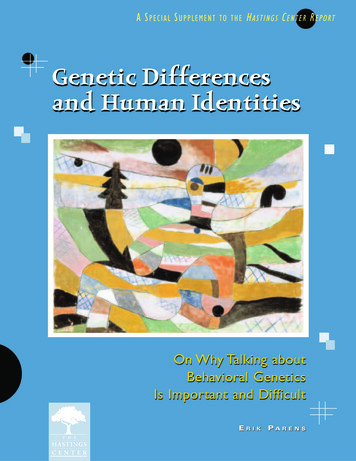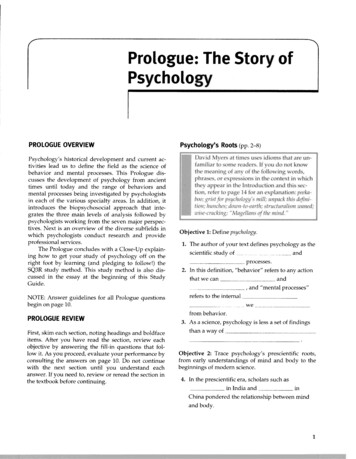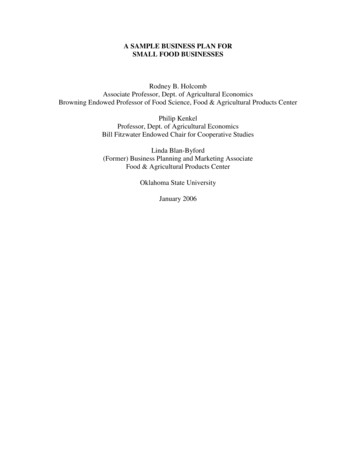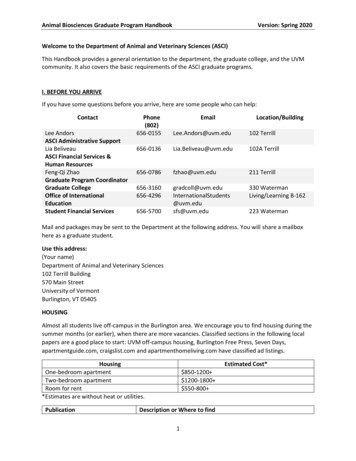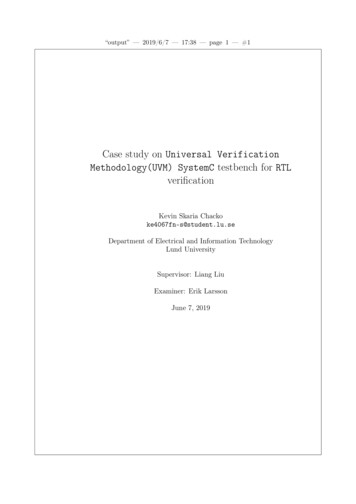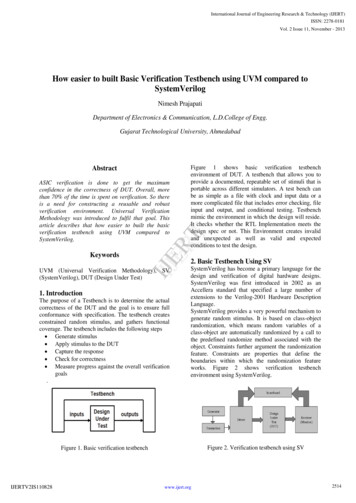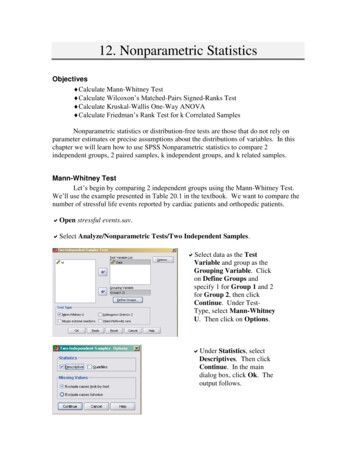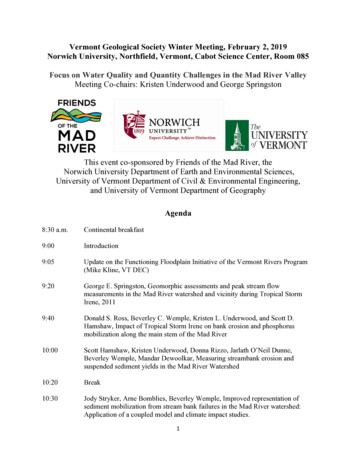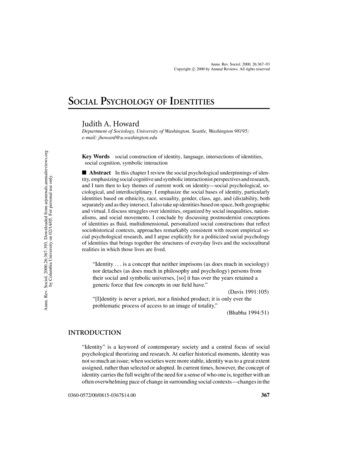
Transcription
P1: FJL/FGDP2: FJSJune 3, 200014:56Annual ReviewsChapter-16Annu. Rev. Sociol. 2000. 26:367–93Copyright c 2000 by Annual Reviews. All rights reservedSOCIAL PSYCHOLOGY OF IDENTITIESJudith A. HowardAnnu. Rev. Sociol. 2000.26:367-393. Downloaded from arjournals.annualreviews.orgby Columbia University on 02/14/05. For personal use only.Department of Sociology, University of Washington, Seattle, Washington 98195;e-mail: jhoward@u.washington.edu?Key Words social construction of identity, language, intersections of identities,social cognition, symbolic interaction Abstract In this chapter I review the social psychological underpinnings of identity, emphasizing social cognitive and symbolic interactionist perspectives and research,and I turn then to key themes of current work on identity—social psychological, sociological, and interdisciplinary. I emphasize the social bases of identity, particularlyidentities based on ethnicity, race, sexuality, gender, class, age, and (dis)ability, bothseparately and as they intersect. I also take up identities based on space, both geographicand virtual. I discuss struggles over identities, organized by social inequalities, nationalisms, and social movements. I conclude by discussing postmodernist conceptionsof identities as fluid, multidimensional, personalized social constructions that reflectsociohistorical contexts, approaches remarkably consistent with recent empirical social psychological research, and I argue explicitly for a politicized social psychologyof identities that brings together the structures of everyday lives and the socioculturalrealities in which those lives are lived.“Identity . . . is a concept that neither imprisons (as does much in sociology)nor detaches (as does much in philosophy and psychology) persons fromtheir social and symbolic universes, [so] it has over the years retained ageneric force that few concepts in our field have.”(Davis 1991:105)“[I]dentity is never a priori, nor a finished product; it is only ever theproblematic process of access to an image of totality.”(Bhabha 1994:51)INTRODUCTION“Identity” is a keyword of contemporary society and a central focus of socialpsychological theorizing and research. At earlier historical moments, identity wasnot so much an issue; when societies were more stable, identity was to a great extentassigned, rather than selected or adopted. In current times, however, the concept ofidentity carries the full weight of the need for a sense of who one is, together with anoften overwhelming pace of change in surrounding social contexts—changes in the0360-0572/00/0815-0367 14.00367
P1: FJL/FGDJune 3, 2000Annu. Rev. Sociol. 2000.26:367-393. Downloaded from arjournals.annualreviews.orgby Columbia University on 02/14/05. For personal use only.368P2: FJS14:56Annual ReviewsChapter-16HOWARDgroups and networks in which people and their identities are embedded and in thesocietal structures and practices in which those networks are themselves embedded.Social cognition and symbolic interaction, two of the prevailing perspectives insociological social psychology, provide the theoretical underpinnings of traditionalunderstandings of identity. In the past several decades, the concept of identity hasbeen taken up more broadly, both within sociology and in other disciplines. In thisessay, I review key questions and recent research on identity in social cognitionand symbolic interaction, then take up key themes of current social psychologicalwork on identity: identity and social inequalities particularly as expressed in raceand ethnicity, gender, sexuality, and other systems of social stratification; researchon how these multiple identities intersect; identities based on locational indicatorssuch as geography, place, cyberspace; questions of the (in)stability of identities;and the politicization of identities.?SOCIAL COGNITIONSocial cognition is a theory of how we store and process information (Fiske &Taylor 1991, Augoustinos & Walker 1995). Social cognition has close roots to psychology and a reliance on experimental laboratory methodologies. Several centralassumptions underlie social cognitive theories of identity: that human cognitivecapacities are limited; that, therefore, we process information as cognitive misers,streamlining information to manage the demands of everyday interaction; that,following from this need for cognitive efficiency, we categorize information aboutpeople, objects, and situations before we engage memory or inferential processes.Cognitive StructuresCognitive schemas, abstract and organized packages of information, are the cognitive version of identities. Self-schemas include organized knowledge about one’sself, the cognitive response to the question of identity: Who am I? These includethe characteristics, preferences, goals, and behavior patterns we associate withourselves. Group schemas (analogous to stereotypes) include organized information about social positions and stratification statuses, such as gender, race, age,or class. Because the social positions we occupy have immediate consequencesfor our sense of self, group schemas play a major part in processes of identification. Self and group schemas illustrate both advantages and disadvantages ofcategorization systems. They allow us to summarize and reduce information tokey elements; thus, they also entail losing potentially valuable information. And,categorizations are almost always accompanied by systems of evaluation of somecategories as better or worse. Schemas are not just perceptual phenomenona; theycan serve as explanatory devices and justifications of social relationships (Tajfel1981). Thus, social identities are embedded in sociopolitical contexts.Social identity theory focuses on the extent to which individuals identify themselves in terms of group memberships (Tajfel & Turner 1986). The central tenet of
P1: FJL/FGDJune 3, 2000P2: FJS14:56Annual ReviewsChapter-16Annu. Rev. Sociol. 2000.26:367-393. Downloaded from arjournals.annualreviews.orgby Columbia University on 02/14/05. For personal use only.SOCIAL PSYCHOLOGY OF IDENTITIES369social identity theory is that individuals define their identities along twodimensions: social, defined by membership in various social groups; and personal, the idiosyncratic attributes that distinguish an individual from others. Socialand personal identities are thought to lie at opposite ends of a continuum, becoming more or less salient depending on the context. Deaux (1993), however, arguesfor an interplay between the two, suggesting they are not easily separable. Social identities provide status and enhance (or not) self-esteem. Because people aremotivated to evaluate themselves positively, they tend to evaluate positively thosegroups to which they belong and to discriminate against groups they perceive topose a threat to their social identity.Empirical support has relied heavily on studies using the minimal groupparadigm (Tajfel 1970), whereby people are classified into distinct groups onthe basis of an arbitrary and trivial criterion under conditions free from other factors usually associated with group memberships. Under these minimal conditions,people do discriminate in favor of in-groups in allocation of various rewards. Themost sociologically relevant recent studies have extended this tradition to sociallymeaningful groups and situations. Simon et al (1997), for example, demonstratethat being in a numerical minority (a predictor of identification in this tradition)does not lead to identification unless the in-group–out-group categorization is situationally meaningful.The more positive, and more personally important, aspects of the self are likelyto be bases on which a person locates her- or himself in terms of collective categories (Simon & Hastedt 1999), demonstrating the relationship between categorization and evaluation. This points toward more successful attainment of a positivesocial identity for those in dominant social groups. This process is a challenge formembers of stigmatized, negatively valued groups, who may attempt to dissociatethemselves, to evaluate the distinguishing dimensions of in-groups as less negative, to rate their in-group as more favorable on other dimensions, or to competedirectly with the out-group to produce changes in the status of the groups. Muchof this research accords considerable agency, both cognitive and material, to socialactors.One relevant line of research explores the psychological consequences of identifications with ethnic in- and out-groups. Fordham & Ogbu (1986), for example, suggest that academic failure among African-American students representsa desire to maintain their racial identity and solidarity with their own culture.High-achieving African-American children develop a “raceless” persona, but atthe cost of interpersonal conflict and ambivalence; adoption of “raceless” behaviorsand attitudes do have negative psychological consequences for African-Americanstudents (Arroyo & Zigler 1995). Direct impression management strategies intended to counter negative evaluations of their in-group also increase, one of manyindicators of the interdependence of cognition and interaction. The focus on psychological consequences of identification speaks also to the interconnectednessof cognition and emotion. Thus, for example, individuals’ prejudices may shapenot only their own identifications but also their categorizations of others. Raciallyprejudiced individuals do appear to be more motivated to make accurate racial?
P1: FJL/FGDJune 3, 2000Annu. Rev. Sociol. 2000.26:367-393. Downloaded from arjournals.annualreviews.orgby Columbia University on 02/14/05. For personal use only.370P2: FJS14:56Annual ReviewsChapter-16HOWARDcategorizations, both in-group and out-group, than do nonprejudiced individuals(Blascovich et al 1997); accurate categorizations maintain clear boundaries between groups.Strong identification with a group need not, in principle, be correlated without-group hostility. Only under conditions of intergroup threat and competitionare in-group identification and out-group discrimination correlated (Branscombe& Wann 1994, Grant & Brown 1995). Social identity theory maintains that it is ingroup identification that causes out-group bias. Realistic conflict theory (LeVine& Campbell 1972), on the other hand, maintains that out-group threat and hostilitylead to in-group identification. In a study of Black South Africans’ ethnic identifications before and after South Africa’s transitional election in 1994, Black Africanidentification was related only to attitudes toward Afrikaans Whites, not whitesin general or English Whites (Duckitt & Mphuthing 1998). Longitudinal analysessuggest that attitudes affected identifications, more consistent with realistic conflict than social identity theory, a useful caution to overly cognitive approaches toidentification.?Cognitive ProcessesCognitive processes are also implicated in the construction, maintenance, andchange of identities. Attribution processes, that is, judgments of blame, causality,or responsibility, are particularly relevant. One key question is whether attributional patterns are biased in accord with intergroup identifications and allegiances.Many studies show a pattern of in-group favoritism such that positive behaviors ofin-group members are attributed to internal factors and negative behaviors to external factors; some, but fewer, studies show out-group discrimination, that is, theopposite patterns of attributions about the behavior of out-group members (Islam& Hewstone 1993, and see Howard 1995). Consistent with social identity theory,when social categorizations are salient, these attributional patterns intensify (Islam& Hewstone 1993).Cognitive structures and processes come together in Moscovici’s (1981) theoryof social representations. According to this perspective, knowledge structures arecollectively shared, originating and developing via social interaction and communication (Augoustinos & Innes 1990). This approach reframes the concept ofschemas, which have generally been seen as conservative and resistant to change.Given an increasing emphasis on social processes, one may expect to see continuing recasting of social schemas as more flexible and more grounded in socialinteraction.Although the experimental tradition has been central to establishing the tenets ofthese theories, validation of these principles in sociologically meaningful contextsis crucial. Various of the studies cited here have been conducted in situations ofreal group memberships and real conflicts, underscoring the Spears et al (1997a,b)assertion that cognitive perception is meaningfully structured by groups and grouplife. One emphasis of this review is that cognitive and interactional processes are
P1: FJL/FGDP2: FJSJune 3, 200014:56Annual ReviewsChapter-16SOCIAL PSYCHOLOGY OF IDENTITIES371intimately intertwined; identity management strategies are often used to manipulate group comparisons for purposes of social identifications (Doosje & Ellemers1997).Annu. Rev. Sociol. 2000.26:367-393. Downloaded from arjournals.annualreviews.orgby Columbia University on 02/14/05. For personal use only.INTERACTIONISM?The basic premise of symbolic interaction is that people attach symbolic meaningto objects, behaviors, themselves, and other people, and they develop and transmitthese meanings through interaction. People behave toward objects on the basisnot of their concrete properties, but of the meanings these objects have for them.Because meanings develop through interaction, language plays a central part (seediscussion below). Identities locate a person in social space by virtue of the relationships that these identities imply, and are, themselves, symbols whose meaningsvary across actors and situations.Interactionist approaches to identity vary in their emphasis on the structureof identity, on the one hand, and the processes and interactions through whichidentities are constructed, on the other. The more structural approach relies onthe concept of role identities, the characters a person develops as an occupant ofparticular social positions, explicitly linking social structures to persons (Stryker1980). Role identities are organized hierarchically, on the basis of their salience tothe self and the degree to which we are committed to them, which in turn dependson the extent to which these identities are premised on our ties to particular otherpeople. The second approach emphasizes the processes of identity constructionand negotiation. Negotiations about who people are are fundamental to developing mutual definitions of situations; these negotiations entail self-presentation orimpression management (Goffman 1959, McCall & Simmons 1978). Identitiesare thus strategic social constructions created through interaction, with social andmaterial consequences.This tradition articulates specific interactive mechanisms through which identities are produced (Cahill 1998). These processes are also always shaped by socialhierarchies, as detailed in Goffman’s ideas about how externally relevant statushierarchies are geared to “interactional cogs,” for example, in his concept of hierarchical observation, the varying degrees to which people can control informationothers have about them. Members of total institutions are subject to compulsoryvisibility, and to “normalizing judgments,” contrasting them to an ideal of a mentally healthy person, a law-abiding citizen, and so forth. Although these processesare most evident in total institutions, Goffman conceives these as more general,occurring in all institutional settings, even in informal interactions.Identity and LanguageHow is identity “done”? The interactionist literature on identity articulates theconstruction, negotiation, and communication of identity through language, both
P1: FJL/FGDJune 3, 2000Annu. Rev. Sociol. 2000.26:367-393. Downloaded from arjournals.annualreviews.orgby Columbia University on 02/14/05. For personal use only.372P2: FJS14:56Annual ReviewsChapter-16HOWARDdirectly in interaction, and discursively, through various forms of media (McAdams1995). At the most basic level, the point is simply that people actively produceidentity through their talk. Many studies (generally ethnographic) analyze identitywork through everyday interaction. Identity talk is organized around two setsof norms, one concerning respect for situated identities and a commitment tobasic moral precepts, and the second concerning ways in which people deal withfailure to endorse these basic moral precepts, through denials of responsibilityand other attributional tactics (Hunt et al 1994). Identity work is a micro-levelperformance of social (dis)order. Hunt & Miller (1997), for example, examineidentity construction through interviews with sorority women, focusing on theirtalk about personal appearance. Their data reveal normative orders associated withdress and appearance; these women communicate, maintain, and repair identitiesthrough a “rhetoric of review” that provides ground rules for critical assessmentsof appearance. (For other examples, see MacPherson & Fine 1995, Freitas et al1997.)Many such studies focus on populations experiencing identity struggles, especially managing the stigma of social inequalities (see Goffman 1963, O’Brien& Howard 1998). Anderson et al (1994), for example, identify two distinct typesof strategies used by homeless people to avoid stigmatization, many of whichrely on language. In-group techniques used among street peers include drinking,cheap entertainment, hanging out, and positive identity talk. Out-group techniques,which reduce the impact of the stigma on public interactions with domiciled others, include passing (presenting an appearance that masks their homelessness),covering (minimizing the impact of their stigmatized status), defiance, and, sometimes, collective action, as in recent homelessness movements. Cherry’s (1995)and Tewksbury’s (1994) studies of people with AIDS also show how their respondents use language and identity performances to control and guide the socialconsequences of this discredited status.In contrast to this emphasis on normative order, identity can be viewed as amore flexible resource in verbal interaction. Using conversational analysis, Antakiet al (1996) show how identities change as interaction proceeds, that is, howcontextual variations shift identity claims. Their examples (drawn from tapes ofnatural English conversation between friends over drinks) show speakers not onlyavowing contradictory identities but also invoking both group distinctiveness andsimilarity. They argue strongly for working from participants’ own orientationsto identity, rather than analytically derived social categories. Verkuyten’s (1997)study of how ethnic minority identity is presented in natural talk, based on focusgroups of Turks living in the Netherlands, suggests the fruitfulness of this approach.Critiquing social identity theory, Verkuyten shows that people construct and crossborders of various categories in defining themselves; respondents did not use fixedcategories, and differentiations were not always oppositional.Language thus links the cognitive and interactive traditions. Hermans (1996)proposes development of a voiced conception of identity that integrates these traditions, a conception that points to collective voices (social dialects, professional?
P1: FJL/FGDP2: FJSJune 3, 200014:56Annual ReviewsChapter-16Annu. Rev. Sociol. 2000.26:367-393. Downloaded from arjournals.annualreviews.orgby Columbia University on 02/14/05. For personal use only.SOCIAL PSYCHOLOGY OF IDENTITIES373jargons, languages of generations and age groups) and facilitates greater recognition of the dynamics of dominance and social power. Rapley (1998) aptly illustrates this last point in his analysis of Australian MP Pauline Hanson’s firstspeech to the Australian Parliament (in 1996). Rapley addre
Social identity theory focuses on the extent to which individuals identify them-selves in terms of group memberships (Tajfel & Turner 1986). The central tenet of . identity management strategies are often used to manipu-late group comparisons for purposes of social identifications (Doosje & Ellemers 1997).

